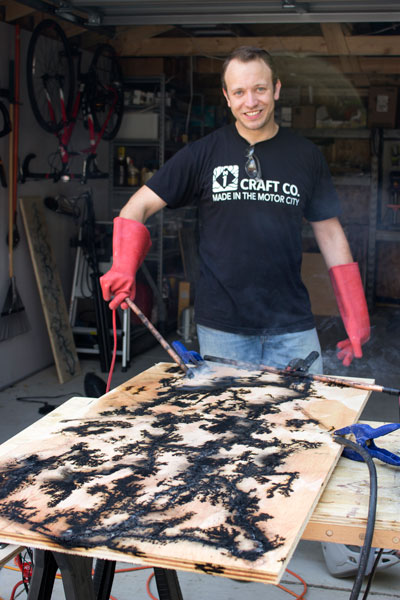
Show Your State Food Some Love!
 Unlike many artisans, Paul can’t say that he was drawn to this and never envisioned anything like this taking place. M1 is more of a culmination of multiple things. Born in Rochester, Michigan, to parents both involved in the automotive industry, he grew up always helping (or “dragged into,” helping, as he says) his parents with projects. Both were hands on, extremely creative, and constantly building and renovating.
Unlike many artisans, Paul can’t say that he was drawn to this and never envisioned anything like this taking place. M1 is more of a culmination of multiple things. Born in Rochester, Michigan, to parents both involved in the automotive industry, he grew up always helping (or “dragged into,” helping, as he says) his parents with projects. Both were hands on, extremely creative, and constantly building and renovating.
Consequently, Paul always thought in a creative fashion, visualizing products, and full of ideas. He just never acted on it. That changed in 2011, when he bought his first house, and realized that he could bring certain ideas to fruition—and he was actually good at working with his hands.
While Paul’s undergrad degree in Supply Chain Management and Masters in business, seem unrelated to what was to become M1 Craft Co., he found a correlation in terms of process management and value-added activities – specifically, creating value for the customer.
When moving into his second home, and shopping for furniture, Paul found himself looking at the design and joinery of the furniture, speculating about the process and perceived versus actual quality, and where the trade-offs were…trying to figure out what a consumer found as value-added, and what people viewed as “quality”.
“With the rise in popularity of the ‘distressed/urban’ style of furnishings, and use of reclaimed wood, there was a huge opportunity to create a product that was not on the market combining many of these features,” he says.
As Paul became more and more handy, naturally, he needed more and more tools. He saw them as continuing the cycle of creating value. His wife was of a different opinion!
“I was constantly getting heat from Kim, my wife, regarding the number of amazon boxes filled with power tools coming to the house. Fortunately, we needed a light fixture for the house, and my excuse was that, ‘I really, really wanted to build one,’ so I created a basic light fixture out of a wooden pot rack saving us a few hundred dollars, offsetting the cost of my most recent purchases,” he says.
During the couple’s housewarming, guests admired his work, and many wanted to buy light fixtures from him.
“This was a huge win! I could fund my power tool purchases AND have some fun creating a unique product. I just had to figure out how to make it unique, he says.
One night, while browsing online, he found a video of students experimenting with creating Lichtenberg figures, using electrical voltage to create patterns similar to a lightning flash. That discovery was Paul’s “flash,” the missing link he had been searching for.
“I always refer to Supply Chain Management as organized chaos. I guess that is the same in regards to the design of the fixtures and other products in the pipeline. Perfect angles and square corners – deliberate designs – combined with the inlaid Lichtenberg figures and panels, results in a design that incorporates geometry and the randomness of nature – no set of figures are ever the same. I think the products offer something that is not only practical and simple, but a conversation piece and art form that can be appreciated as well as used in everyday life,” Paul says.
I’m an entrepreneur at heart, and following the renovations of my previous house, I realized how much I enjoyed working with my hands. I designed and built a simple light fixture made from a wooden pot rack in our home prior to our housewarming party, “just to see what would happen.” Our guests loved it – some asked me to build a few for them. I responded that I would make something unique, based on the design, but it would be a design of my own.
My New Year resolution in 2016 was to launch a start-up. It was a tough year, and I wanted to do something mentally therapeutic—something simple, fun, and innovative, with a product that did not exist in the consumer market; something that could be a centerpiece to an environment. Fortunately, this happened organically – I needed to pay for the power tools I continued to purchase, and selling these lights did just that (hahaha…seriously, my wife was NOT pleased with the amount of amazon orders coming to the house!)…before I knew it I had a product, I just needed a presence and a name. After some thinking, I chose to use “M1” in the name as a tie to metro Detroit. From there, M1 Craft Co. was up and running and I was selling these handmade fixtures!
Ed. Note: M1 is a Detroit highway, known as “Detroit’s Main Street”
It is very satisfying, very therapeutic, to take something from concept to market under your own terms, and it be a centerpiece of your home – a conversation piece. There is a unique story behind the product, the city it comes from, and how it is created. With the unique interior design styles and trends that continue to emerge, there is always opportunity to continue to develop this product, and similar products, to fit the market demand.
As a metro Detroit native, and a child of the automotive industry, we have all grown up around innovation. Both my parents were engineers at a local OEM, and I grew up surrounded by parents that loved working with their hands and the creative outcomes that come with it. This is my chance to make my mark and produce a product inspired by the community I grew up around.
It keeps one grounded. Raw materials are cheap (depending on the product, of course). The value of a product is created by the ingenuity and resourcefulness of the builder.
In what ways are handmade goods better than those that are mass produced?
There is a lot of value, perceived and actual, associated with having a handmade good in your home. It is not necessarily a guarantee of quality, and mistakes can happen when building any product, however there is a level of satisfaction for the consumer knowing they are purchasing something that was built by someone’s bare hands, from start to finish.
When someone is making something by hand, there is a vested interest associated with the item. There is certainly no problem with a mass-produced good; there is a huge variety of consumers with various interests.
With a handmade good, a person’s time, energy, and dedication was put into it, from start to finish. I know I would never want my name associated with a mediocre good, and I think a lot of artisans would feel the same way.
I have plans to expand the product line to include floating shelving, kitchen tables, and a living room set with end tables and coffee tables. I’m not sure when; I’m going to take this one step at a time, just like how we came into business, and see what happens.